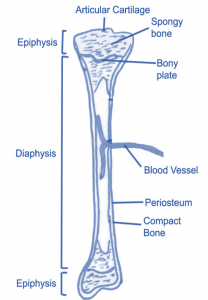Structure of a long bone
Bone is a rigid, non-elastic tissue, which is composed of approximately 65% mineral components (calcium phosphate and magnesium salts) and 35% organic tissue such as collagen (a structural fibrous protein which helps give bones some resilience and prevents them from breaking easily).
Mature bones consist of cells called osteocytes which exist in spaces known as lacunae. These bone cells are supported by thick collagen fibres which exist in a matrix composed of minerals.
There are two types of bone tissue:
- Compact bone: this is also known as hard bone. It is heavy, dense and strong, and has an ivory appearance. It forms the surface layer of all bones and the whole of the cylindrical shaft of long bones (the diaphysis). Compact bone is thickest at the centre of the shaft where the bone is weakest. It helps to protect bones from external impacts or forces and has great weight-bearing properties. A fibrous and extremely vascular (possessing a good blood-supply) tissue known as the periosteum, completely surrounds the compact bone. Periosteum is vital in bone development, and enables tendons to attach to bones, allowing movement to take place.
- Cancellous bone: this is also known as spongy bone. It lies underneath and alongside compact bone, and has a honeycomb appearance. This criss-cross matrix of bony plates is developed along lines of stress on the bones and is constantly reorganised in response to the altering course of stress. The matrix combines strength with the minimum of weight, enables bones to take stress, yet be light and easily moved. Cancellous bone is found mainly in the ends of bones where they flare out to form joints (epiphysis). This increases the surface area for more stable joints. The spaces within the cancellous bone are filled with red bone marrow allowing the manufacture of red blood cells. Bones are extremely vascularised (have a very good blood supply). This enables nutrients to reach the bone and blood cells produced within the bone to enter the circulatory system.

